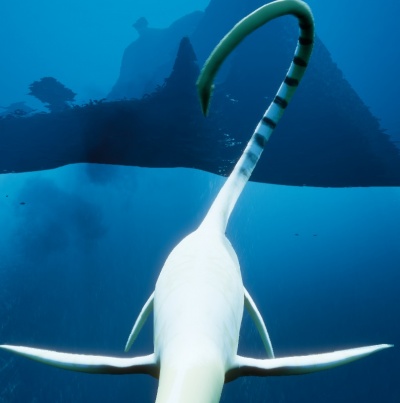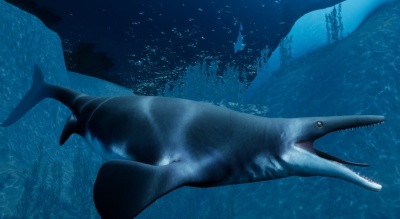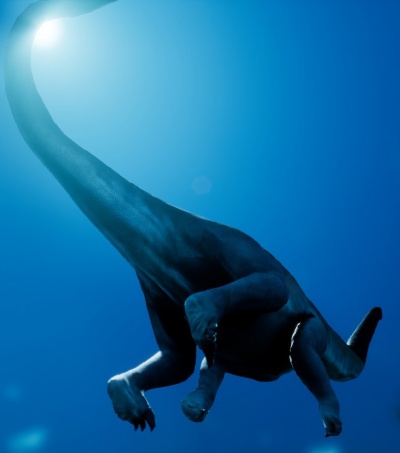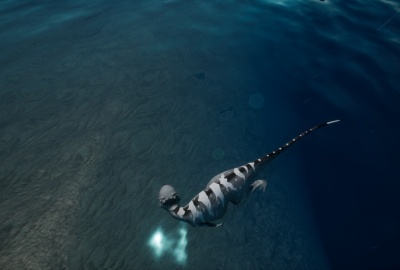Difference between revisions of "Swimming"
Bermudabeast (talk | contribs) (Created page with "When an animal is in the water, if their feet cannot touch the bottom, they are considered to be swimming. Swimming is one of three types of movement, the others being Move...") |
Bermudabeast (talk | contribs) |
||
| Line 1: | Line 1: | ||
| − | When an animal is in the water, if their feet cannot touch the bottom, they are considered to be swimming. Swimming is one of three types of movement, the others being [[Movement System|terrestrial movement]] and [[Flight|flight]]. Playable creatures in Beasts of Bermuda harbor a wide array of aquatic capabilities. | + | When an animal is in the water, if their feet cannot touch the bottom, they are considered to be swimming. Swimming is one of three types of movement, the others being [[Movement System|terrestrial movement]] and [[Flight|flight]]. Playable creatures in Beasts of Bermuda harbor a wide array of aquatic capabilities, ranging from ineptitude to proficiency. |
| + | |||
| + | == Swimming as an Aquatic Creature | ||
| + | |||
| + | [[File:ElasmoInWater.jpg|right|thumb|400px|border|The [[Elasmosaurus]] is Graceful in the Water]] | ||
| + | |||
| + | [[File:MosaInWater.jpg|right|thumb|400px|border|The [[Mosasaurus]] is Happy in the Water]] | ||
| + | |||
| + | [[Aquatic Creatures|Aquatic creatures]] live their entire lives in the water, and thus are highly specialized for aquatic movement. An entirely different style of movement has been granted to these animals. Rather than using the turn radius style movement most terrestrial creatures follow, aquatic creatures can change their orientation simply by having the player move their [[Camera|camera]], often very swiftly. The creature will always face the direction of the camera while the player is holding forwards, but will rotate left, right, or towards the camera if the player presses other movement keys. This is different than terrestrial creatures, where orientation of their animal will follow a more fixed radius on the terrain. Aquatic creatures are indeed very agile swimmers. | ||
| + | |||
| + | Aquatic creatures are significantly faster than their terrestrial counterparts while in the water. Most have speeds exceeding even the swiftest land animals. | ||
| + | |||
| + | Rather than be concerned with immediate death by [[Drowning|drowning]], aquatic creatures must manage their [[Air|air supply]] using a different, more dynamic, specially designed mechanic. More aerobic activities deplete air faster than sedentary activities. Replenishing air is as simple as returning to the surface for a breath. | ||
| + | |||
| + | Swimming up and down can be controlled both with the pitch angle of the [[Camera|camera]] as well as with use of the [[Jumping|jump]] and crouch [[Keybinding|keybinds]]. | ||
| + | |||
| + | == Swimming as a Terrestrial Creature == | ||
| + | |||
| + | [[File:ApatoInWater.jpg|right|thumb|400px|border|The [[Apatosaurus]] is Aloof in the Water]] | ||
| + | |||
| + | [[File:PachyInWater.jpg|right|thumb|400px|border|The [[Pachycephalosaurus]] is Scared in the Water]] | ||
| + | |||
| + | [[Terrestrial Creatures|terrestrial creatures]] are unanimously poor swimmers. They float lazily to the surface when no control input is provided by the player. Use of [[Jumping|jump]] and crouch will allow the player to slowly ascend or descend in the water. Unlike aquatic creatures, they do not have a separate, dedicated system designed around their swimming capabilities. They are often restricted to a similar [[Movement System|movement type]] they are bound to on land, where turn radius and speed dictate their course for the most part. Worse, with the exception of the [[Acrocanthosaurus]], they suffer a further reduced rate of turning while swimming. Most of these creatures are very easy prey for aquatic creatures while in the water, and can put up little fight. | ||
| + | |||
| + | Some terrestrial creatures cannot use their [[Primary Attack|attacks]] or [[Secondary Attack|abilities]] in water. Most notably, the [[Apatosaurus]] and [[Parasaurolophus]] cannot [[Stomping|stomp]]. | ||
| + | |||
| + | Terrestrial creatures will suffer extreme loss of [[Comfort|comfort]] if swimming in deep [[Ocean|saltwater]]. | ||
| + | |||
| + | While submerged, terrestrial creatures are at risk of [[Drowning]]. | ||
| + | |||
| + | == Swimming as a Semiaquatic Creature == | ||
| + | |||
| + | The [[Ichthiovenator]] will be the first [[Semiaquatic Creatures|semiaquatic creature]] added to Beasts of Bermuda. It is not yet in-game, and the mechanics of semiaquatic swimming have yet to be completed. | ||
| + | |||
| + | == Swimming as a Flying Creature == | ||
| + | |||
| + | The [[Pteranodon]] will be the first [[Flying Creatures|flying creature]] to be added to Beasts of Bermuda. It is not yet in-game, and the mechanics of flying creatures in the water have yet to be completed. | ||
Revision as of 19:51, 6 July 2017
When an animal is in the water, if their feet cannot touch the bottom, they are considered to be swimming. Swimming is one of three types of movement, the others being terrestrial movement and flight. Playable creatures in Beasts of Bermuda harbor a wide array of aquatic capabilities, ranging from ineptitude to proficiency.
== Swimming as an Aquatic Creature


Aquatic creatures live their entire lives in the water, and thus are highly specialized for aquatic movement. An entirely different style of movement has been granted to these animals. Rather than using the turn radius style movement most terrestrial creatures follow, aquatic creatures can change their orientation simply by having the player move their camera, often very swiftly. The creature will always face the direction of the camera while the player is holding forwards, but will rotate left, right, or towards the camera if the player presses other movement keys. This is different than terrestrial creatures, where orientation of their animal will follow a more fixed radius on the terrain. Aquatic creatures are indeed very agile swimmers.
Aquatic creatures are significantly faster than their terrestrial counterparts while in the water. Most have speeds exceeding even the swiftest land animals.
Rather than be concerned with immediate death by drowning, aquatic creatures must manage their air supply using a different, more dynamic, specially designed mechanic. More aerobic activities deplete air faster than sedentary activities. Replenishing air is as simple as returning to the surface for a breath.
Swimming up and down can be controlled both with the pitch angle of the camera as well as with use of the jump and crouch keybinds.
Swimming as a Terrestrial Creature


terrestrial creatures are unanimously poor swimmers. They float lazily to the surface when no control input is provided by the player. Use of jump and crouch will allow the player to slowly ascend or descend in the water. Unlike aquatic creatures, they do not have a separate, dedicated system designed around their swimming capabilities. They are often restricted to a similar movement type they are bound to on land, where turn radius and speed dictate their course for the most part. Worse, with the exception of the Acrocanthosaurus, they suffer a further reduced rate of turning while swimming. Most of these creatures are very easy prey for aquatic creatures while in the water, and can put up little fight.
Some terrestrial creatures cannot use their attacks or abilities in water. Most notably, the Apatosaurus and Parasaurolophus cannot stomp.
Terrestrial creatures will suffer extreme loss of comfort if swimming in deep saltwater.
While submerged, terrestrial creatures are at risk of Drowning.
Swimming as a Semiaquatic Creature
The Ichthiovenator will be the first semiaquatic creature added to Beasts of Bermuda. It is not yet in-game, and the mechanics of semiaquatic swimming have yet to be completed.
Swimming as a Flying Creature
The Pteranodon will be the first flying creature to be added to Beasts of Bermuda. It is not yet in-game, and the mechanics of flying creatures in the water have yet to be completed.